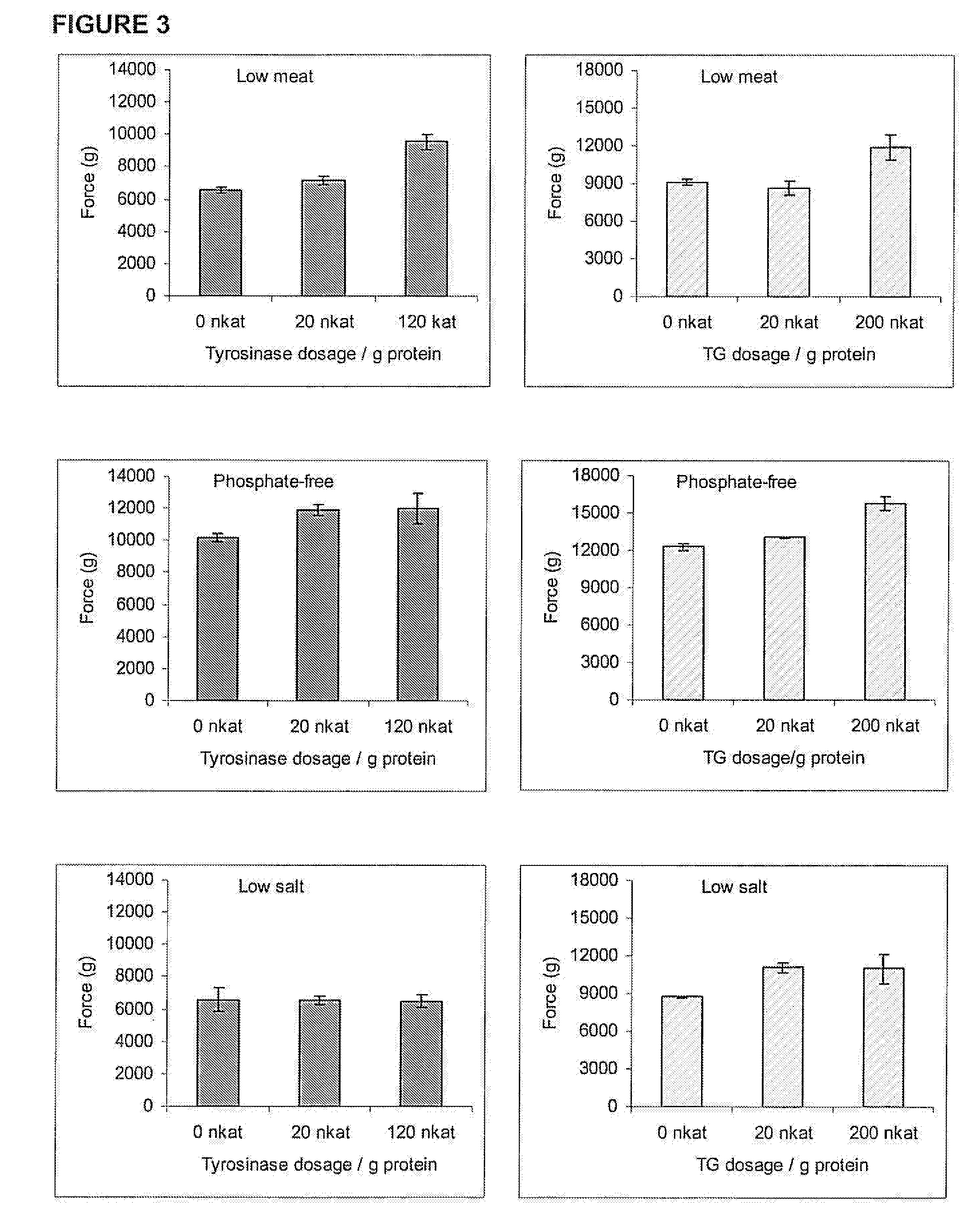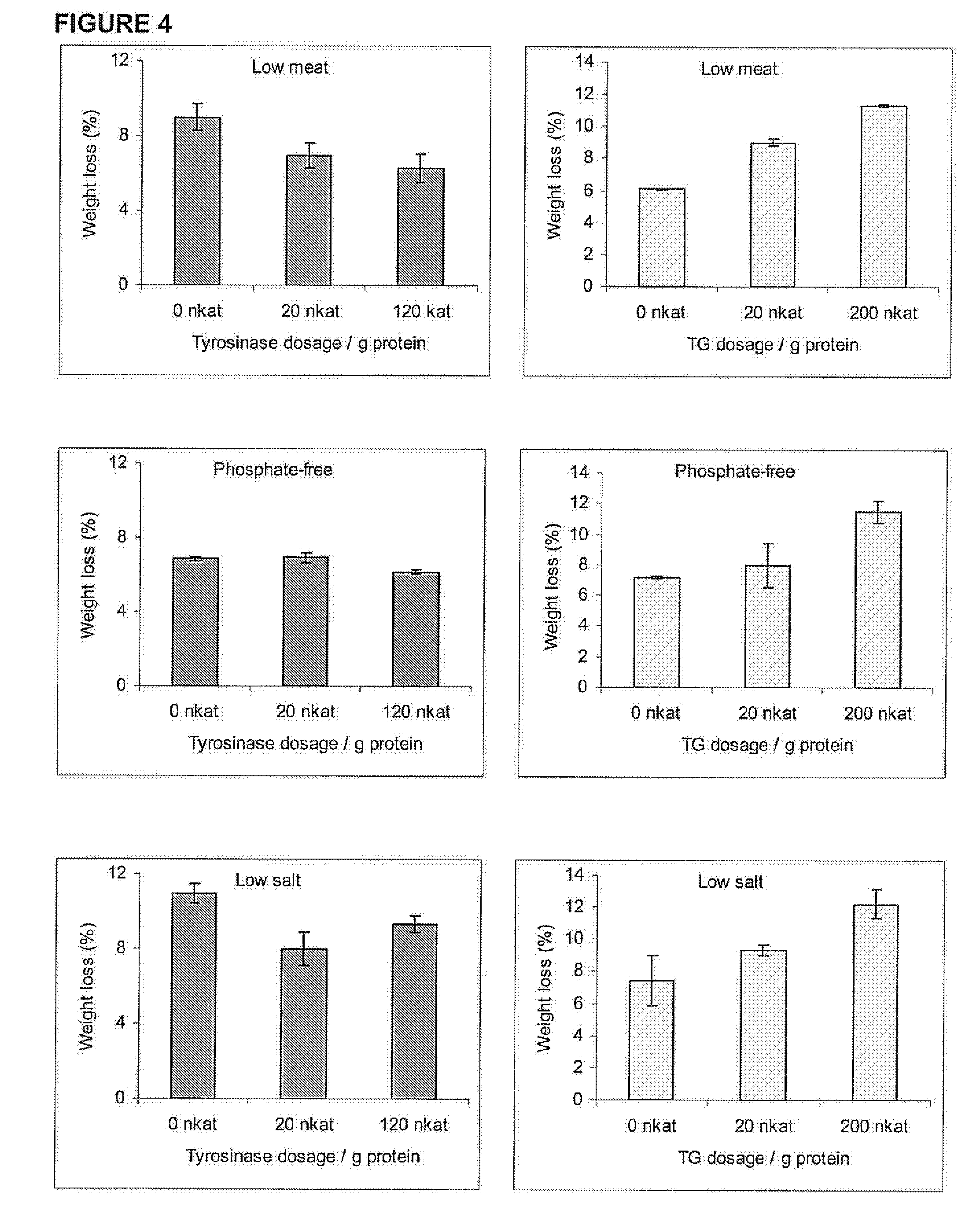Low-ingredient meat products and method for their preparation
a low-ingredient, meat product technology, applied in the field of preparing a low-ingredient meat product, can solve the problems of increasing weight loss, weakening of texture, and rarely straightforward salt reduction
- Summary
- Abstract
- Description
- Claims
- Application Information
AI Technical Summary
Problems solved by technology
Method used
Image
Examples
example 1
Tyrosinase-Catalyzed Crosslinking of Myofibril Proteins Isolated from Chicken Breast Muscle
[0039]Changes in the molecular weight and mobility of the isolated salt soluble proteins (SSPs) of chicken breast myofibrils caused by Trichoderma reesei tyrosinase were analysed by sodium dodecylsulphate-polyacrylamide gel electrophoresis (SDS-PAGE). SSPs were isolated according to Xiong and Brekke (1989). SSPs were suspended in 50 mM Na-phosphate buffer, pH 6, containing 0.6 M NaCl to the protein concentration of 3 mg / ml. 60, 120 and 240 nkat of tyrosinase was added per g of protein. The reaction mixtures were incubated at 40° C. Samples were drawn at time points of 5 min, 1 hour, 3 hours and 18 hours. The major changes in protein bands on SDS-PAGE catalysed by tyrosinase were tentatively identified. Tyrosinase caused the following detectable electrophoretic changes: 1) appearance of large molecular protein below the well, 2) disappearance of myosin heavy chain, and 3) disappearance of tropo...
example 2
Tyrosinase-Catalyzed Crosslinking of Myofibril Proteins Isolated from a Rainbow Trout Fillet
[0040]Changes in the molecular weight and mobility of the isolated myofibril proteins of rainbow trout fillet caused by T. reesei tyrosinase were analysed by SDS-PAGE. Myofibril proteins were isolated essentially in the same way as the chicken breast myofibrils in Example 1. Isolated myofibrils were suspended in water containing 8% of sucrose in order to keep the proteins in solution pH of the suspension was not adjusted. First myofibril proteins (3 mg / ml) were treated with different amounts of tyrosinase in order to evaluate the crosslinking efficiency of the enzyme. 20, 40, 80, 160, 320 and 640 nkat tyrosinase was added per g of protein. The reaction mixtures were incubated at 40° C. for 2 hours, after which samples of the reaction mixtures were run to SDS-PAGE.
[0041]According to the SDS-PAGE results, tyrosinase dosages of 160 and 640 nkat / g were chosen for further studies. Next the efficie...
example 3
Improvement of Gel Forming of Chicken Myofibrils by Tyrosinase
[0043]Ability of tyrosinase to form crosslinks in a 4% chicken myofibril suspension was investigated as a development of storage modulus (G′) measuring gel-forming improvement by tyrosinase at low deformation. Measurements were carried out during heating at 25° C. and 40° C. using a Bohlin VOR rheometer (Bohlin Reologi, Lund, Sweden) (FIG. 1). Chicken breast myofibrils were isolated according to Xiong and Brekke (1989) omitting EDTA and NaN3 from the isolation buffer Isolated myofibrils were suspended to the protein concentration of 4% in 50 mM Na-phosphate buffer −0.35 M NaCl, pH 6. Samples of the myofibril suspension were treated with 0, 30, 60, 120 and 240 nkat of T. reesei tyrosinase / g of protein at 25° C. and 40° C. for 3 hours. The results show a greater increase in G′ in tyrosinase treated myofibril suspensions than in those treated only in buffer. Furthermore, increase of the treatment temperature intensified gel ...
PUM
 Login to View More
Login to View More Abstract
Description
Claims
Application Information
 Login to View More
Login to View More - R&D
- Intellectual Property
- Life Sciences
- Materials
- Tech Scout
- Unparalleled Data Quality
- Higher Quality Content
- 60% Fewer Hallucinations
Browse by: Latest US Patents, China's latest patents, Technical Efficacy Thesaurus, Application Domain, Technology Topic, Popular Technical Reports.
© 2025 PatSnap. All rights reserved.Legal|Privacy policy|Modern Slavery Act Transparency Statement|Sitemap|About US| Contact US: help@patsnap.com



